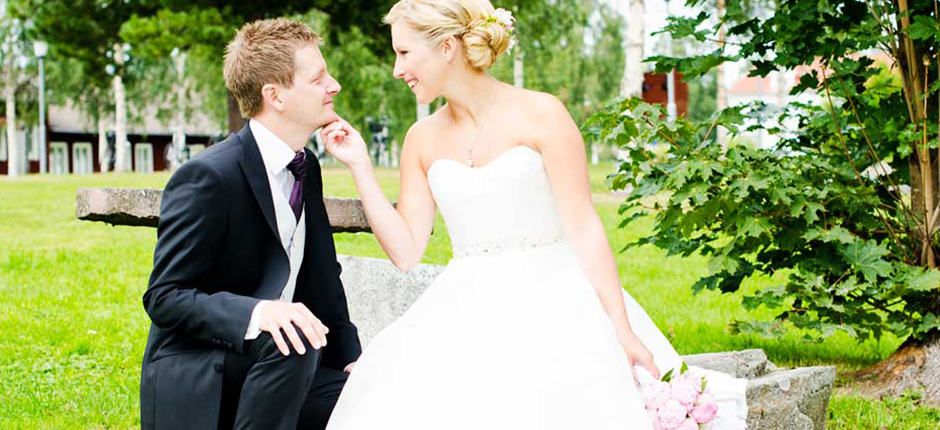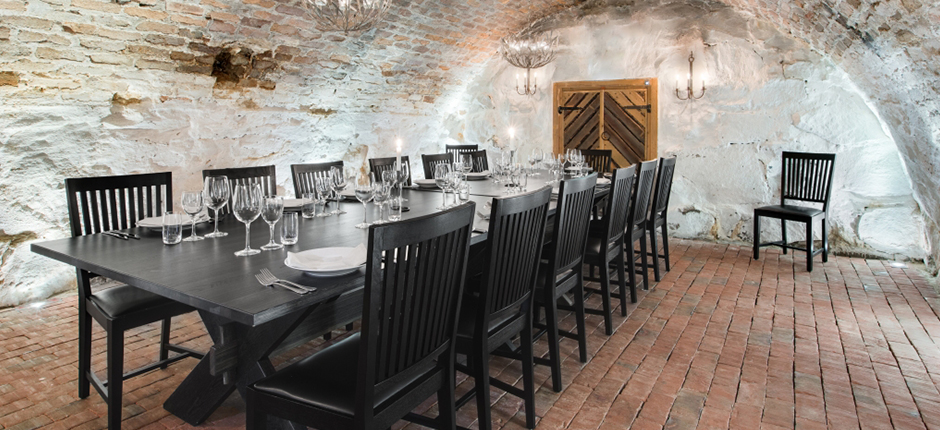A historic place
The story about Stiftsgården

Take a look at Stiftsgården’s history
Fires, wars and famous visitors … a lot has happened here at Stiftsgården!

Gustav Vasas bible 1540
1507
When the first vicarage is being built, you do not know for sure, but the medieval church is inaugurated this year and the vicarage was probably erected at the same time.
1531
The vicarage is burning, “In 1531, all Schelleta’s priesthood burned, the day before Michaelis evening.”
1534
Sweden’s first Protestant Archbishop Laurentius Petri to visit. Schelleta vicarage had thus left Catholicism, following an order from a central point. He is received by Mr Björn who will also be the first priest in Skellefteå to be allowed to marry, according to the new Protestant rules.
1584
Gerhard Jonae is the priest who comes to the vicarage this year. He is the same and has a son named Johan. The son will be the first same to enter Sweden’s Knights House. Johan then serves as governor of Öster- and Västerbotten and fights witchcraft declarations.
1681
The vicarage is burning again. A new building is being built quickly and in 1700 a house inspection is being carried out to inspect the new buildings.
1694
Great visit to the vicarage. King Karl XI travels to Torneå and stops on both the up and down journey. He has dinner and visits the old medieval church.
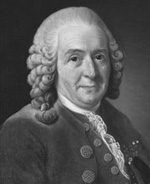
Carl von Linné
1733
Carl von Linné visits the vicarage and is amazed at how beautiful and comfortable it is in the Skelleft district.
1735
The old ferry across the Skellefte River is replaced by the longest wooden bridge in the kingdom. In the vicarage, the former head pastor Petrus Anzenius houses what is known as the least popular church pastor of all time. He is, among other things, behind the introduction of stock punishment in the Skelleftebygden and a hole next to the vicarage is designated after his departure as the place where “the prince of darkness brought his soul to the abode of the unholy”.
1752
This year, Church Reverend Pehr Högström and his family receive King Adolf Fredrik on his Norse trip. He has moved out of the vicarage so as not to unnecessarily burden the public with great costs. His new use is called Äppelböle. Here, Västerbotten’s first apple ripens, and plum, pear and cherry trees as well as oxen and hazel bushes thrive. Unfortunately, most of it freezes during the harsh winter of 1763.
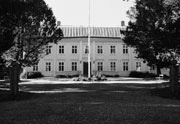
Skellefteå prostgård
från 1802
1800
Nils Ström becomes new church pastor. He comes to a vicarage in great disrepair. All buildings, except the old basement with its long staircase, are unusable. However, major efforts have been made on the land church, which was renovated after Jakob Rijf’s drawings to be inaugurated in 1799. Now it is time for a vicarage which is built with inspiration from Säbro bishop’s yard outside Härnösand. The parish appropriates 2000 riksdaler and some building materials. But it is not enough on long roads and the priest Ström is bankrupt on his absence.
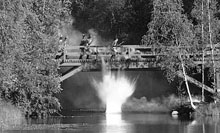
Slaget om Skellefteå
15 maj 1809
1809
The Ström family flees and Swedish officers headquarters in the rectory. On May 15, it will be feared. The Russian invade from the north. Instead, it is the Russian general Schuvaloff who takes possession of the vicarage. Margareta Renhorn acts hostess during the Russian “visit” so charming that she probably saves the vicarage from the usual Russian farewell greeting, that the buildings are set on fire. The Ström family returns, but people in the area then have little to spare for the “saved stream”.
Peace between Russia and Sweden.
1817
Big riot in the vicarage when four of the reading movement’s leadership figures infiltrate the Reformation Jubilee Day. You are upset by the preaching of the priest Ström. The situation is so tense that a royal commission, headed by Justice Joshua Sylwander, is sent to Skellefteå to mediate. At a later meeting in the church, the upset feelings are calmed.
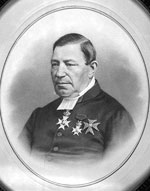
Nils Nordlander
Skellefteås grundare
1834
One of the foreground figures of the Skellefte district Nils Nordlander arrives in Skellefteå as the first elected church pastor. He engages in most things; arranges city rights for Skellefteå in 1845, is a co-founder of the educational institution in 1860, as well as Sparbanken, which is set up in the vicarage. He feels sorry for the poor and the school system.
1858
A party in connection with King Charles XV’s visit causes great conflict between father and son Nordlander. Daniel’s son, who is part of the king’s entourage, has defied his father’s ban on liquor and arranged a banquet to the celebrated guests upstairs of the vicarage. However, great joy for the art-interested parents, however, is the daughter Anna, one of the Academy’s first female students and even in our days an esteemed artist with “own” museum in the city. She is already deceased at 36 years of age in the lungs.
1867
There is famine in the countryside after misgrowth and sad harvests. In the vicarage large pots of soup are cooked every day for the starving. This year and 1868 are the worst years of emergency in memory of men.
1875
The vicarage becomes the center of a revival that is powerfully advancing through the countryside. This happens in conjunction with the arrival of the pastor Simon Brandell.

Systrarna Brandell
på utflykt ca 1900
1878
Skellefteå missionary association is created by Brandell and the vicarage becomes a gathering place for colorful preachers and large crowds of people. Wife Anna bases the household where there is a lot of life and movement. Now up to ten baptisms a day are held in the vicarage.

Utsikt från Landskyrkans torn ca 1890
1901
Prästgårdens östra flygel brinner och kyrkoarkivet skadas svårt. Rykten gör gällande att kyrkoherden Carl Theodor Åbergs son, sedermera kringvandrande gårdfarihandlare, har varit i slagsmål med en kamrat och slagit ner en brinnande fotogenlampa. En ny flygelbyggnad uppförs och prästgården renoveras, bl a sätts moderna kakelugnar in.
1923
Kristian August Fellström blir ny kyrkoherde. Han sitter som ordförande i kyrkostämma, skolråd, länsskolråd och fattigvårdstyrelse. Under hans tid sker stora förändringar i samhället och många av dessa uppgifter övertas av stat och kommun.
1940
Svenska officerare upprättar förläggning i prästgården. Gårdsplanen täcks av militärtält och en längre tid avvaktas här utvecklingen i Norge under andra världskriget.
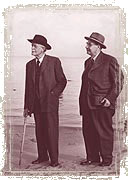
Prosten Fellström och F.A Hedman
1945
Kriget är över och grupper av nord-finska flyktingar kommer till bygden. Prästgårdens västra flygel blir ett ”kris-centrum”, bl a finns där insamlade kläder och skor som delas ut till de behövande.
1948
Nymodigheten skolfrukost serveras Brännanskolans elever i en av flygelbyggnaderna.
1949
Ett paradisäppelträd, planerat av Pehr Högström på 1700-talet dör mitt under sin försommarblomning i prästgårdens trädgård, till sorg för de församlade.
1952
Makarna Fellström avslutar sin gärning i prästgården och Axel Boström flyttar in. Nu påbörjas en genomgripande renovering, bl a flyttas salongen till husets nedre plan. Religionsfrihet.
1964
Luleå stifts Stiftsgård skapas och blir ett hem för hela Luleå stift, en central plats för kurser och fortbildningar. Här hålls nu utbildningar av olika slag, konfirmandläger och retreater.

Interiör från Kapellet
1977
En separat kursgård med 15 rum och en föreläsningssal byggs. Senare renoveras redskapsboden till konferenslokalen Ryggåsstugan.
1993
Ytterligare tillbyggnad genomförs och samtidigt kompletteras anläggningen med en vacker trädgård som binder samman prästgården och kyrkan. Trädgårdens medeltida inspiration ger också associationer till prästgårdens tidigare dagar. Stiftsgården är nu en modern konferensanläggning med hög standard.
1997
Ett litet kapell invigs på området. Här kan konferensbesökare samlas för en stunds eftertanke, meditation och andakt.
2006
The Pehr cellar opens. A unique restaurant environment in the old 17th century basement with vaulted ceiling in hand-made bricks.
2011
The upper salon is inaugurated and dedicated to Lars Jonsson. With this, Stiftsgården has again been given a parlor on the upper level, just as on the days of the Nordlander family, and another unique meeting place.
2012
The second floor is inaugurated. The upper floor of the main building, through a collaboration with MAN – Museum Anna Nordlander, becomes an art museum for Anna Nordlander’s art. In Anna Nordlander’s childhood home one can now see about thirty of her works. Anna has moved home.
2013
Miss Huss Spa & relax is built in the courtyard for the benefit of conference guests and other residents. A place for relaxation, socializing and hot baths. Miss Huss (Anna Huss) became priest Brandell’s third wife and when in 1879 she moved to Stiftsgården and Skellefteå she had the farm’s first bath in the luggage. A great event for the Brandell family and all the staff – a real bathtub!


